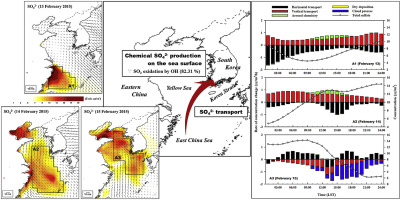当前位置:
X-MOL 学术
›
Atmos. Environ.
›
论文详情
Our official English website, www.x-mol.net, welcomes your
feedback! (Note: you will need to create a separate account there.)
Behavior of sulfate on the sea surface during its transport from Eastern China to South Korea
Atmospheric Environment ( IF 4.2 ) Pub Date : 2018-08-01 , DOI: 10.1016/j.atmosenv.2018.05.017 Wonbae Jeon , Yunsoo Choi , Jeonghyeok Mun , Soon-Hwan Lee , Hyun-Jeong Choi , Jung-Woo Yoo , Hyo-Jung Lee , Hwa Woon Lee
Atmospheric Environment ( IF 4.2 ) Pub Date : 2018-08-01 , DOI: 10.1016/j.atmosenv.2018.05.017 Wonbae Jeon , Yunsoo Choi , Jeonghyeok Mun , Soon-Hwan Lee , Hyun-Jeong Choi , Jung-Woo Yoo , Hyo-Jung Lee , Hwa Woon Lee

|
Abstract This study investigates the production/loss of sulfate on the sea surface during its transport from Eastern China to South Korea (Korea). We use the Community Multi-scale Air Quality (CMAQ) model to simulate sulfate concentrations in February 2015 and to examine the changes in them. Results of the CMAQ simulation show high sulfate concentrations over the sea surface areas between Eastern China and Korea despite nearly zero emissions. Their concentrations gradually increased (from 0.371 to 0.581㎍/m3/h) as they passed through the East China Sea, the Yellow Sea, and the Korea Strait. The results from a quantitative analysis using the integrated process rate (IPR) in CMAQ suggest that increasing sulfate concentrations during the transport was mainly attributable to chemical sulfate productions by the aerosol process (up to 0.866㎍/m3/h) and vertical transport (up to 0.994㎍/m3/h) of chemically produced sulfate, resulting from vertical momentum transport caused by vertical wind shear and temperature gradient. The results of the sulfur tracking model (STM) in CMAQ verify that the OH + SO2 → H2SO4 + HO2 reaction was the largest contributor (82.31%) to the production of sulfate over the sea surface areas during its transport. Surplus SO2 in the transporting plume reacted to abundant OH over the sea surface, formed H2SO4, and contributed to the consequently increased sulfate concentrations. The observed sulfate data in Korea confirm that sulfate concentrations over the sea surface areas enhanced sulfate concentrations in Korea (from 12.27 to 13.74㎍/m3). The sulfate, however, was not directly transported from upwind regions but chemically produced during the transport. The results of several sensitivity simulations with varied meteorology revealed that the changes in chemical sulfate production rates during the transport of sulfate were mainly affected by temperature.
更新日期:2018-08-01











































 京公网安备 11010802027423号
京公网安备 11010802027423号